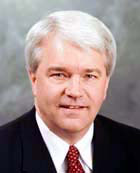As President Barack Obama and the U.S. Congress head for a final showdown over long-stalled health-care reform legislation, pundits are struggling to explain an array of arcane congressional rules and protocols that may determine whether health-care reform passes or dies on the vine.
Many of these pundits are getting it wrong, suggests congressional expert Steven S. Smith, Ph.D., one of the nation’s leading scholars of Senate politics and policymaking and the Kate M. Gregg Distinguished Professor of Social Sciences at Washington University in St. Louis.
“Over the past quarter century, a parliamentary arms race between the parties has emerged in the U.S. Senate,” says Smith, a professor of political science in Arts & Sciences and director of the university’s Murray Weidenbaum Center on the Economy, Government, and Public Policy.
“These developments have caused considerable confusion among senators, the media and the public about the Senate’s recent history. Filibusters, reconciliation, holds, unorthodox post-passage mechanisms and other developments have spurred waves of commentary, much of it inaccurate and ahistorical,” Smith says.
Reconciliation, the tactic Democrats are expected to use in a last-ditch effort to pass health-care reform, is just one of the many controversial congressional procedural maneuvers explained in Smith’s essay on “Partisanship and Procedural Battles in the U.S. Senate, 1960-2010.”

While Republicans now portray potential use of the reconciliation process as a ruthless power grab, Smith notes that the tactic has been used very successfully by Republican leaders such as Bob Dole, Trent Lott and Bill Frist.
The reconciliation process, provided for in the Budget Act of 1974, allows legislators to impose limits on debate and amendment-making to avoid filibusters on legislation providing tax cuts.
Adopted in the midst of budget battles with the Nixon Administration, these new parliamentary restrictions on the use of filibusters and other stalling tactics have “turned Senate procedures on their head,” Smith writes.
Since then, reconciliation has been used by both parties for a wide variety of legislation, including by Democratic congressional majorities in 1987 for the creation of federal nursing home standards and by Republican majorities in 1997 for the Children’s Health Insurance Program.
The precedent for passing measures that reduce revenues as reconciliation bills was established in 1996, when a Republican majority rejected a point of order raised by Sen. Tom Daschle, then the minority leader, on a party-line vote, Smith says.
It’s also noteworthy, says Smith, that the Clinton White House considered using reconciliation for health care reform in the 103rd Congress (1993-1994), but the idea was dismissed as impractical. Tax bills taken up as reconciliation measures were vetoed by President Bill Clinton in 1999 and 2000.
Republicans once again resorted to the use of reconciliation in 2001 to avoid filibusters on one of their key legislative agenda items — large tax cuts proposed by the Bush Administration. With the Senate split 50-50 between the parties and the Republican vice president giving the Republicans official majority status, the Republicans authorized separate reconciliation bills for tax cuts in the budget resolution.
Republicans used the reconciliation process once again in 2003 to push through more tax legislation, Smith says.
While current news is focused on potential use of the reconciliation process to push through health-care reform, Smith contends that all of the ongoing parliamentary battles in Congress are spurred in some form by efforts to circumvent the Senate’s most distinctive rule, Rule XXII.
Also known as the cloture rule, Rule XXII is the key process that allows a large minority of senators to block votes on most legislative matters.
Consequently, Smith says, the most important developments in the modern procedural history of the Senate involve efforts to deploy, adapt, reform or circumvent the super-majority requirements for cloture under Rule XXII, which in the absence of unanimous consent, requires a super-majority of senators to support a cloture motion to impose limits on debates and amendments.
“The result of the arms race is a procedural environment that is more complex than the environment several decades ago,” Smith says. “It is an environment that requires strategists to be far more expert in parliamentary rules and precedents, encourages more gamesmanship by senators and their parties, and intensifies frustration with the Senate among both insiders and outsiders.”